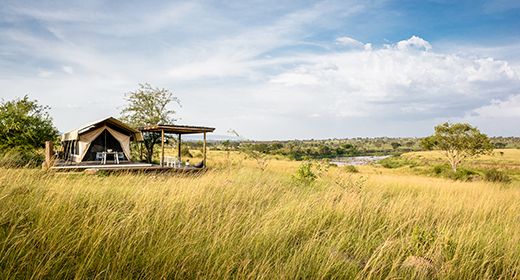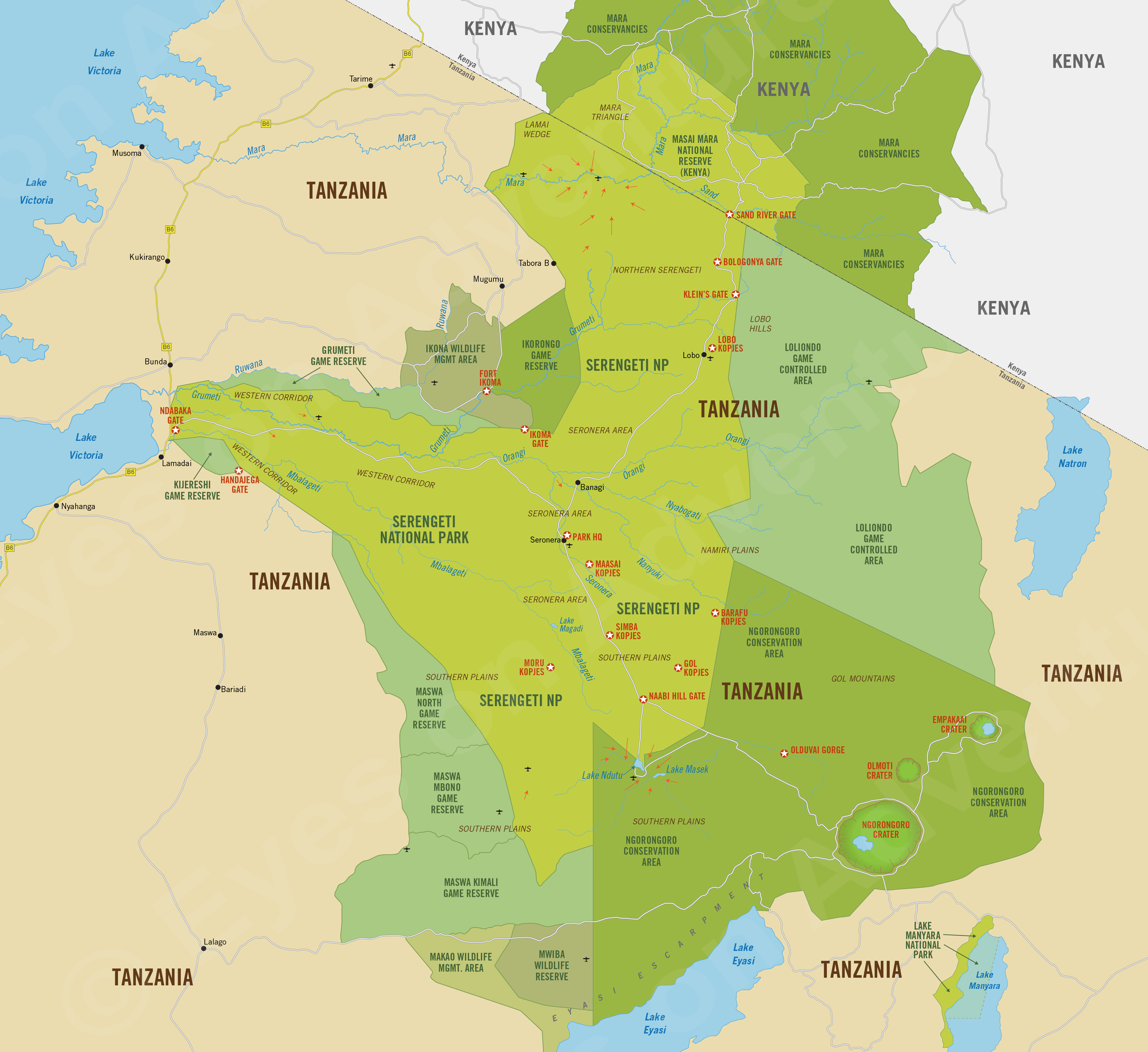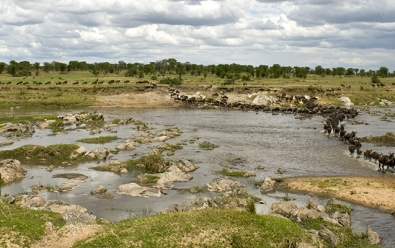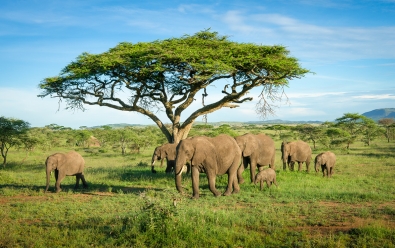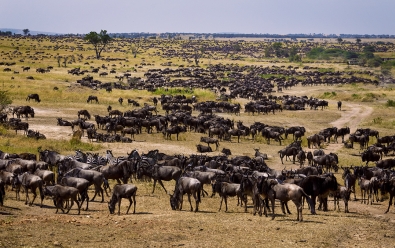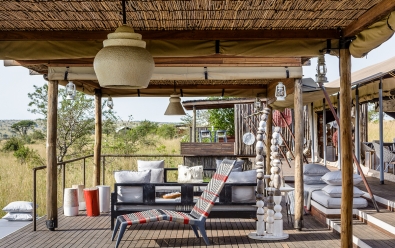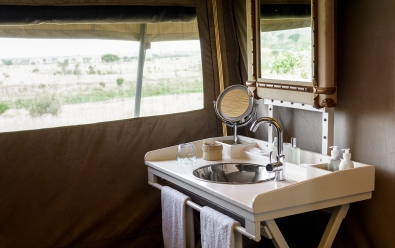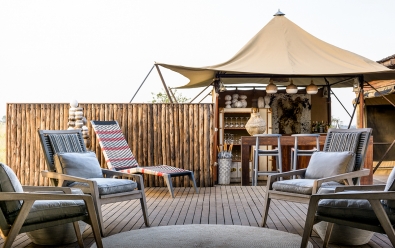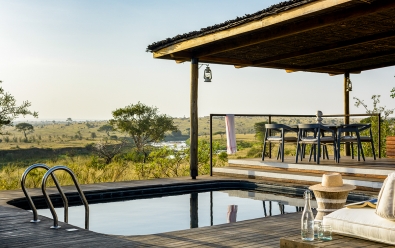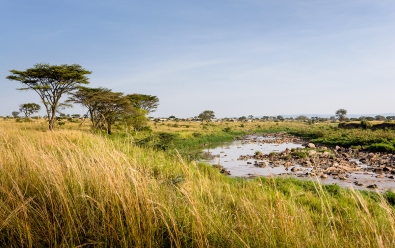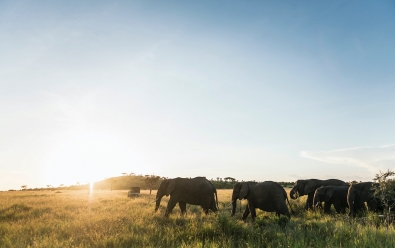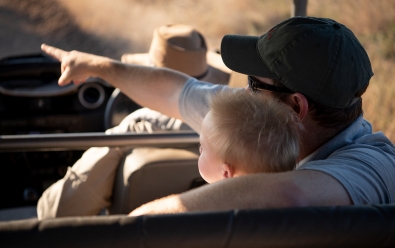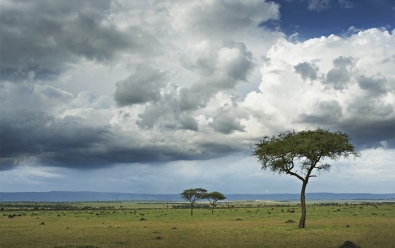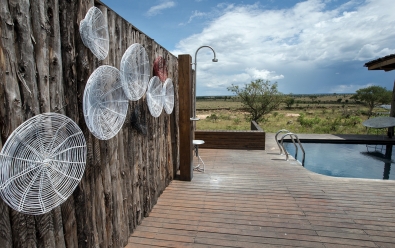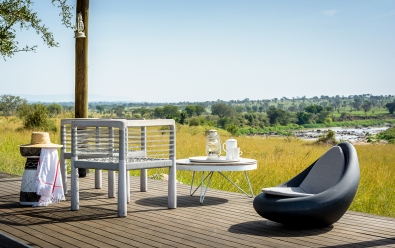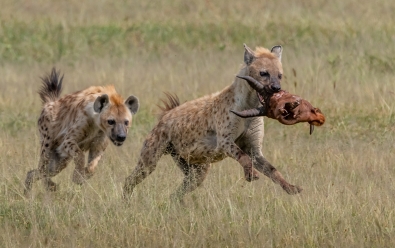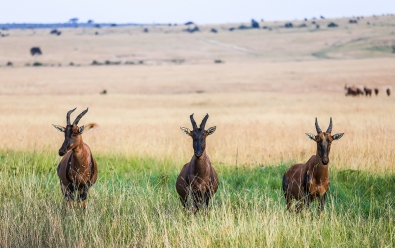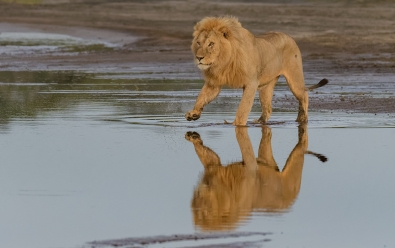Singita Mara River Tented Camp
Highlights
- On the Great Migration route (between August and October)
- Located in one of the most remote sections of the Serengeti
- Very few safari camps in this area, so never crowded
- Positioned overlooking the Mara River
Location
- Northern / Lamai Wedge / Mara River
- Serengeti National Park
- Northern Tanzania
Singita Mara River Tented Camp is located in the remote and wildlife-rich 'Lamai Wedge' section of Serengeti National Park.
Mara River Camp offers its guests an exclusive experience, with only a few other safari camps located in this far northern sector and its position overlooking the renowned Mara River is in a prime position to view wildlife.

Lounge area at Mara River Tented Camp.
The Lamai Wedge area is located in the path of the Great Migration of over two million blue wildebeests and zebras that pass through on their way north to Kenya's Masai Mara between mid-August and October (note that the timing varies somewhat year to year based on local rainfall). Lamai is not just a seasonal area, it offers good to excellent wildlife viewing throughout they year.
Mara River Camp is a modern version of the East African safari of Colonial times, with the tents furnished in contemporary décor and comfortable luxury. Canvas, natural stone, African fabrics, and locally created art complement one another and encourage guests to feel a connection to the natural world surrounding the camp.

Guest tent bedroom at Mara River Camp.
Mara River Camp offers 4 one-bedroom classic-style safari tents and 2 two-bedroom tents that accommodate 2 adults and 2 children.
The main area of the camp provides an excellent space to dine or enjoy a refreshing drink by the pool while watching for wildlife along the river. Inside the lounge, muted fabrics keep the temperature cool during the midday period between safari activities.
Singita are one of Africa's leading safari operators and they strive to minimize energy consumption at all their camps. Singita Mara River operates completely on a customized solar power system and uses recycled and natural materials wherever possible. Strict eco-friendly environmental standards are maintained so that no harmful chemicals or waste is allowed to enter the pristine ecosystem of the Serengeti.
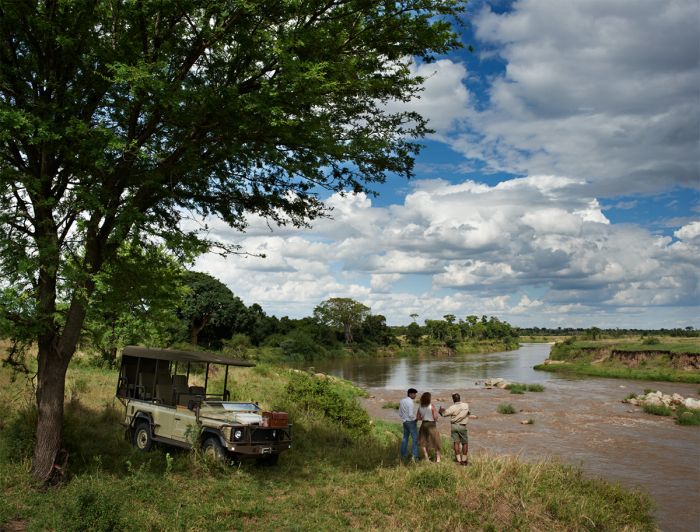
The camp is located along the Mara River in northern Tanzania.
About the Serengeti
The Greater Serengeti is part of an extensive ecosystem that includes Serengeti National Park, the Ngorongoro Conservation Area, and other reserves, wildlife management areas, and game controlled areas.
The Greater Masai Mara (directly to the north in Kenya) includes the Masai Mara National Reserve, as well as numerous private Mara conservancies. Together, the combined Greater Serengeti-Mara ecosystem, which combines the areas described above, covers roughly 15 000 square miles (39 000 sq kms).
The Serengeti-Mara is home to a very large number and diversity of wild animals and is also the location of the well-known "Great Migration" of over 2 million herbivores (read more below). This is arguably Africa's greatest overall wildlife destination.
Wildlife densities in the Greater Serengeti are some of the highest in Africa, with commonly seen herbivores including blue wildebeest, plains zebra, Thomson's gazelle, topi, Grant's gazelle, hartebeest, giraffe, elephant, buffalo, impala, waterbuck, bushbuck, warthog, and many others. Predators seen often include lion, leopard, spotted hyena, cheetah, serval, and jackal. Hippo and crocodile are found in large numbers in the larger rivers, including the Mara River and the Grumeti River.
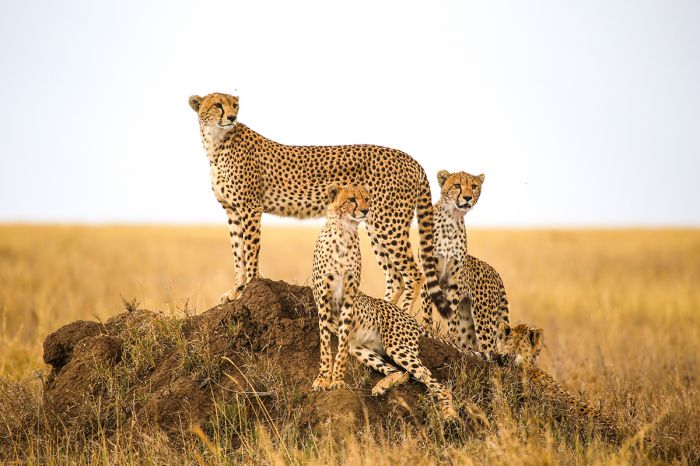
The Serengeti is one of the best destinations to see cheetahs.
About the Lamai Wedge
The Lamai Wedge is a triangular-shaped section of land in the far north of Serengeti National Park. Lamai is defined by the Mara River on the south, the national park boundary on the west, and the international boundary with Kenya on the north. Lamai covers 153 square miles (397 sq kms) of untouched wilderness and is seasonally rich in wildlife. Lamai is contiguous with the 'Mara Triangle' section of the Masai Mara across the border in Kenya.
The Lamai area becomes an amazing place to be when the herds of wildebeest and zebras arrive on their migration north towards Kenya's Masai Mara National Reserve just across the border. The migration usually crosses through Lamai between mid-August and October (note that the timing is never precise and differs a bit year to year).
Most of the camps in the northern Serengeti near the Mara River are located on the southern side of the Mara River, while there are only a handful of safari camps located north of the river in Lamai.
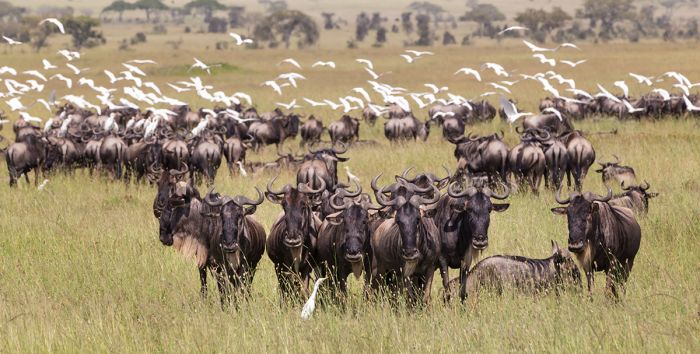
Wildebeests in dry grass during the Great Migration.
Crossings of the Mara River by hundreds of thousands of wildebeests and zebras are a dramatic sight to witness, with large crocodiles waiting in the water for a chance to gorge themselves on the herbivores. Guests staying in safari camps located in Lamai are able to see these crossings with the herds swimming towards them, which provides for spectacular viewing and photographic opportunities.
Further north and away from the Mara River, Lamai is defined by rolling savanna grasslands, rocky outcrops (known as 'kopjes'), and open woodlands.
Wildlife viewing in Lamai is good year-round as well, even outside of the Great Migration months, with regular sightings of elephant, topi, eland, buffalo, Grant's gazelle, Thomson's gazelle, spotted hyena, jackal, and all of the big cats, including lion, leopard, and sometimes cheetah. Rhino are seen on occasion.
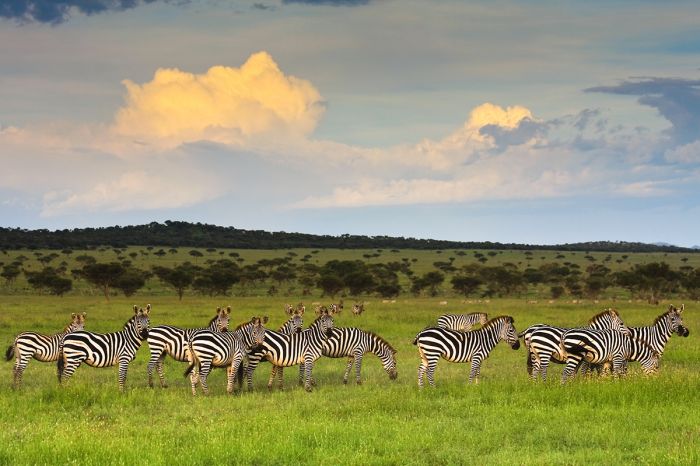
Zebras grazing in the Serengeti.
The Great Migration
One of nature's greatest living spectacles is the Great Migration, a term given to describe the year-long, circular, clockwise march of over two million herbivores across the Serengeti and Masai Mara grasslands. The migration animals are made up entirely of two species: the blue wildebeest and the plains zebra (the majority of which are wildebeests).
The migrating herds follow their instincts to seek out fresh grazing and so the migration is ongoing, with the herds ever moving and taking a full year to complete a cycle across the Serengeti and Masai Mara. The animals move not as one herd, but as tens of thousands of animals in multiple herds of various sizes and spread out for many miles as they move.
The wildebeests and zebras take advantage of strongly seasonal conditions, spending the wet season (November through May) on the plains of Tanzania's Serengeti and the dry season in Kenya's Masai Mara. The wildebeests give birth between January and March on the short grass plains in the southern Serengeti.
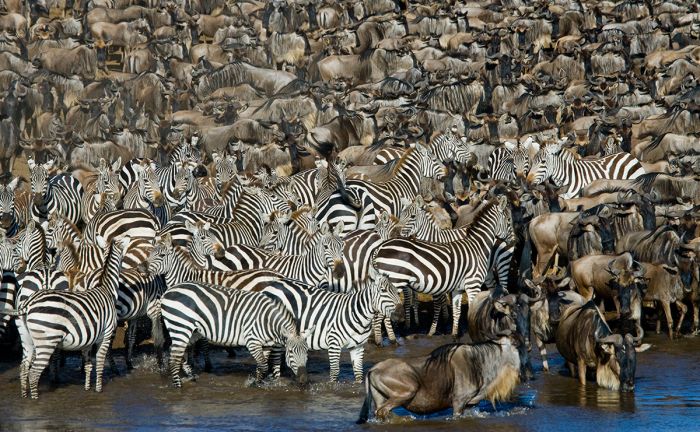
The Great Migration of wildebeests and zebras.
The timing of the migration is rarely ever the same year-to-year, as local conditions influence grass growth and as such, the location of the bulk of there animals cannot be known precisely. Rains and other unknown conditions seem to direct the timing of the migration, but generally, it is known within several weeks when the animals will be in a general location.
The animals spread out to cover a vast area, but the main bulk of the animals moves south into the northern Serengeti around late-October and continue moving south towards the Serengeti's southern plains, arriving there sometime in January to graze on the rich grass growing on the volcanic soils. It is here on these short-grass plains, between January and early March, when the wildebeests give birth to their young en masse, producing some 500 000 baby wildebeests.
The herds remain on the southern short-grass plains until late March, giving the young animals time to grow and become strong, before heading north and west again. Many of the animals move towards the Serengeti's Western Corridor and Grumeti Reserve and the rest straight north into Central and Northern Serengeti, where they remain during June and into July. The herds move back into Kenya starting in late July, with the bulk moving into the Masai Mara in August.
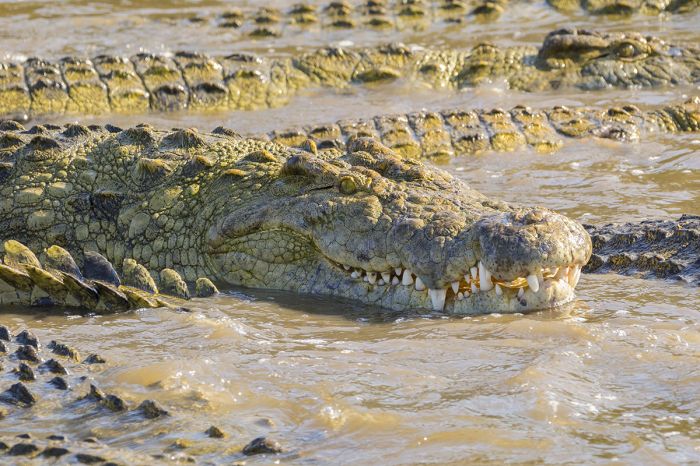
Nile crocodiles hope for a meal during dramatic river crossings.
Although many visitors time their visit to the Serengeti to coincide with the Migration, any region within the Serengeti offers very good wildlife viewing outside of the months when the migration may be present. This is because it is only the wildebeests and zebras that migrate, while the rest of the animals, including the major predators like lion, leopard, spotted hyena, and cheetah, as well as all the other herbivores, including springbok, gazelles, elephant, topi, hartebeest, and many others, do not migrate.
A popular aspect of experiencing the Great Migration is observing a herd as it crosses the Mara River, which requires animals swimming through waters inhabited by large Nile crocodiles that wait for a chance to get their first substantial meal in many months.
The dramatic river crossings (which take place along the Mara River in both Kenya and Tanzania) are certainly a spectacle and not for the faint of heart, with many of the wildebeest and zebras taken by crocs or succumbing to drowning or trampling in the chaos. The best chances for seeing a Grumeti River crossing is in June, while Mara River crossings are best in July and August.
ROOMS INCLUDES & EXCLUDES CHILDREN FACILITIES ACTIVITIES
Accommodation
6 guest accommodations in total comprising:
- 4 one-bedroom tents.
- 2 two-bedroom family tents (2 adults and 2 children).
Each one-bedroom tent is river-facing and includes en-suite bathrooms with an outdoor bathtub, indoor shower, outdoor shower, single-basin vanity, and toilet. These tents can be either be made up as a double or a twin. There is also an outdoor deck area. No triples are possible.
Each two-bedroom tent is river-facing and includes en-suite bathrooms with an outdoor bathtub, indoor shower, outdoor shower, single-basin vanity, and toilet. These tents can be either be made up as a double or a twin. There is also an outdoor deck area shared between the two tents. No triples are possible.
The guest tents are connected to the main camp area by footpaths on the ground.

Guest tent interior at Mara River Tented Camp.
The guest tents are furnished in a relaxed elegance, with African colors blending with cooling muted cotton to create an authentic space for relaxation when not out on a safari drive. Local artisans and craftsmen created the lovely pieces that enhance the camp spaces.
Other items and features in the guest tents include:
- Pedestal fan.
- Minibar (cooler box).
- Tea and coffee station.
- Mosquito netting over the bed.
- Safe.
- Bathroom amenities.
- Small game-viewing deck.
Mara River Camp can accommodate a maximum of 16 guests in total: 2 persons in each of the 4 one-bedroom tents and 4 persons each in the two two-bedroom tents.
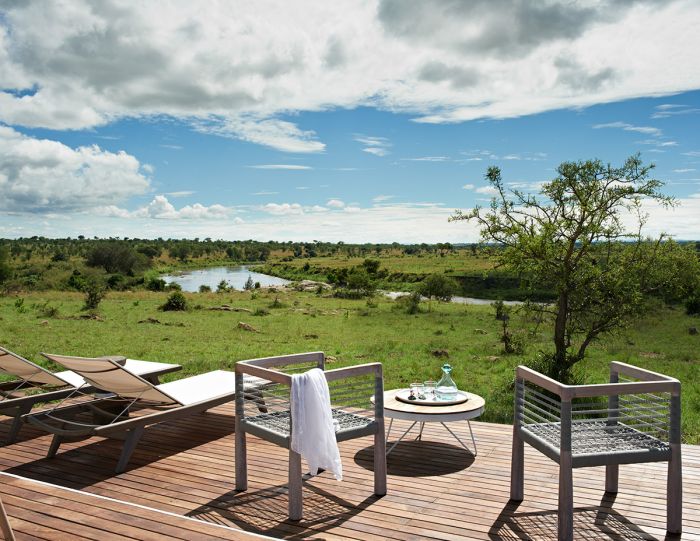
Guest tent view towards the Mara River.
Includes & Excludes
Includes:
- All meals and beverages (including premium wines, spirits and liqueurs, but excluding French Champagne).
- Twice-daily game drives in open game-viewing vehicles.
- Return road transfers between the Serengeti Lamai airstrip and the camp.
- Very limited laundry service. Small amounts can be done on-site (24-hour turnaround); large amounts done off-site (72-hour turnaround).
Excludes:
- Wildlife fee, park fee, concession fee, tourism development levy.
- Carbon offset levy.
- Purchases from the Singita Boutique & Gallery.
- French Champagne.
- Massage treatments.
- Any additional activities not mentioned above.
- Transport to and from other safari camps.
- Any applicable wildlife fee, park fee, reserve fee, concession fee, other land-use fee.
Single Supplement
A single supplement may apply for any tent booked by a single traveler; please ask us for pricing.
Children
Children aged 10 years and older are welcome at Singita Mara River Camp.
Encountering Africa’s magnificent wildlife is a truly life-changing experience, no matter what one’s age, and time spent at Singita Mara River makes for an unforgettable family holiday. Filled with discovery and shared connections within nature, it’s an ideal opportunity to open children’s eyes to the wonders of an untouched wilderness.
All activities at the lodge are tailored to specifically suit the interests of each family. In the interest of safety, children may participate in game drives and bush walks at the discretion of dedicated Field Guides. The lodge also offers child-minding services as well as an array of activities to keep little ones engaged and entertained.
Singita's exciting Mini Rangers Course is a customized, fun-filled program that opens up a whole new world to young explorers. It includes learning how to track animals, astronomy, bush survival techniques, animal-, tree-, and bird-spotting competitions, as well as nature quizzes.
More children’s activities offered:
- Cooking interactions.
- Board games.
- Stargazing.
- Bush walks (minimum age 16).
- Activity booklets with a variety of games, quizzes and games.
- Arts & Crafts.
- Swimming.
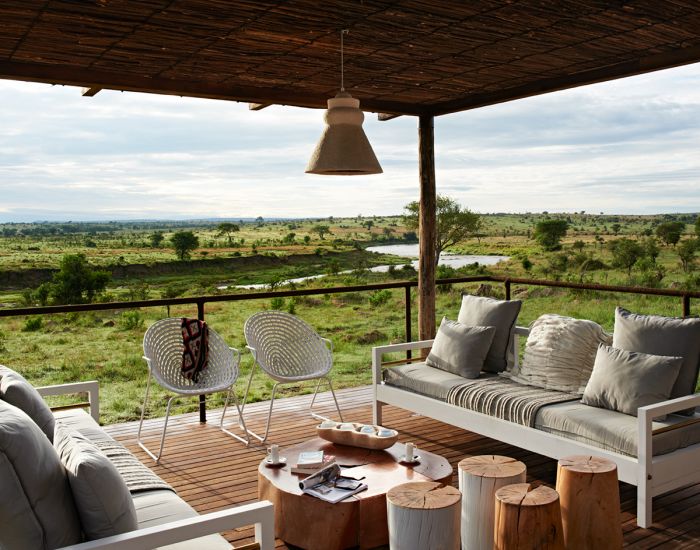
Main camp area view to the Mara River.
FACILITIES
The main area of the camp provides an excellent space to dine or enjoy a refreshing drink by the pool while watching for wildlife along the river. Inside the lounge, muted fabrics keep the temperature cool during the midday period between safari activities.
Other main guest area facilities include:
- There is a plunge pool in the main camp area.
- There is no television at this camp.
- There is complimentary internet (WiFi) access, however due to the remote location of the lodge, the wireless connection can be slow and intermittent.
- Electricity/power available: Solar-powered, with international plug points and gently-powered.
Activities
The area where Mara River Camp is situated is on the route of the world-famous migratory route. The Great Migration traditionally moves through Lamai between mid-August and October. Outside of the migration season, there is plenty of resident wildlife to be seen in this area, including the big cats (lion, leopard, and cheetah), as well es elephant, buffalo, giraffe, topi, and many more.
Safari game drives to see the wildlife are conducted twice daily, once in the early morning (with something to eat and coffee, tea, or juice beforehand) and again in the afternoon. Middays are typically spent at the camp, but full-day drives are possible, particularly during the migration months. Game drives and safari walks are led by expert professional guides.
Activities included in the rate:
- Twice-daily game drives in open 4x4 Land Cruisers (4 guests per vehicle).
- Birding.
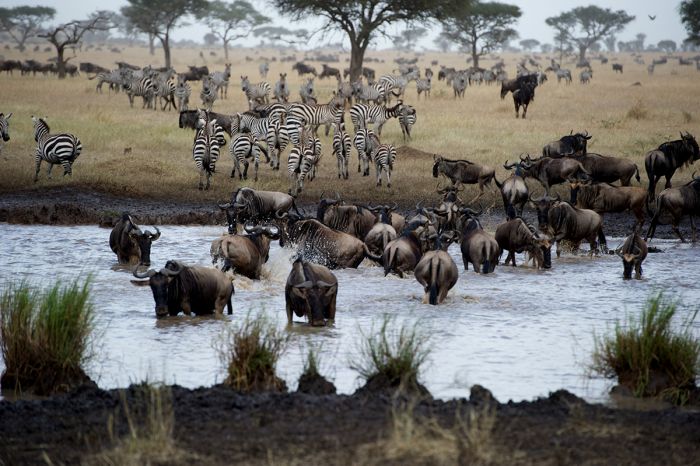
Wildebeests and zebras gathered at the river in front of Mara River Camp.
Optional activities at additional cost:
- Private activities are on offer (subject to vehicle availability which needs to be booked in advance).
- Wellness treatments.
Example of a typical day:
- Early morning wake-up call. Morning wake-up and activity times vary according to the seasons, activities on offer, and wildlife sightings.
- Light breakfast before departing on the morning activity.
- Return to the lodge for a meal and rest period.
- Meet for afternoon tea and snacks (savory and sweet choices) before departing on the activity.
- Return to camp - freshen up or meet for drinks, followed by dinner.
- Enjoy a nightcap and/or discussion at the bar or around the campfire before retiring.
Great Good Fair Poor
- Jan
- Feb
- Mar
- Apr
- May
- Jun
- Jul
- Aug
- Sep
- Oct
- Nov
- Dec
General Tips
It is advised to avoid the Serengeti over March and April, when heavy rains typically occur. June to mid-October is excellent for general game viewing. The large herds of animals in the Great Migration usually cross into the Serengeti from Kenya's Masai Mara sometime around early October and move north back into Kenya around mid- to late-July.
Besides the Great Migration, the other big factor that impacts a stay in the Serengeti is rains. The region experiences most of its rain between November and May, but there are two somewhat distinct rain seasons, the 'short' rains and the 'long' rains (read more below).
Singita Mara River Tented Camp is closed from 15 January - 31 May.
Rains
Short Rains
The short rains occur for about one month sometime during November and December (the exact time varied somewhat year to year). This period is called the 'short' rains because the duration of an individual rain event is short and it is rare to have an all-day rain event. Most rain falls as an afternoon shower, while mornings are typically overcast or clear.
Long Rains
The long rains occur between March and May, with April being the wettest month of the year. During this tome, rain should be expected almost every day and the showers can last for hours at a time, although all-day rain is not typical. The roads in the Serengeti become muddy and very difficult in places, which can hamper game drives. Cloudy skies are typical and temperatures can be chilly at times.
The period between the short and long rains (January and February) also receives rain, but many days are clear and the amount and duration of the rain events is unpredictable, with some afternoon showers and the odd long and heavy rainfall event.
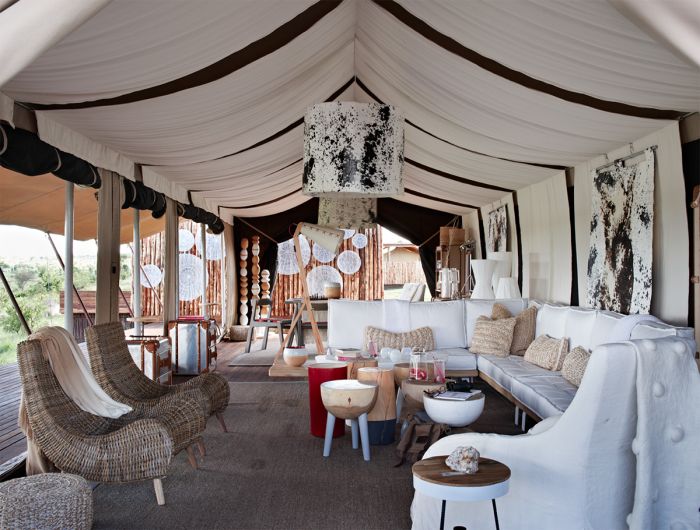
Main area tent at Mara River Camp.
Temperatures
The temperatures in the Greater Serengeti do not experience wide fluctuation throughout the year, as the region lies between one and three degrees south of the equator. In general, daytime temperatures are comfortably warm and overnights and early mornings are chilly. Bring a fleece and rain jacket regardless of the timing of your visit.
Dry Season
The dry season (June to October) is sunny and warm most days and rarely hot. Rare rain showers can occur but are unlikely. From June thru August, the afternoon temperature averages 76-78°F (24-25°C), but some days can be warmer. Evenings and early mornings temperatures are often chilly, averaging 53-55°F (12-13°C).
September and October days are very pleasant, with temperatures averaging 80-83°F (28-30°C), with cool mornings persisting, averaging 53-56°F (11-13°C).
Rainy Season
The rain season is November through May (read more above) and the temperatures are fairly static throughout the season. Daytime temperatures average 79-83°F (26-28°C) and nighttime and early morning temperatures are chilly, but slightly warmer than the dry season, averaging 54-57°F (12-14°C)
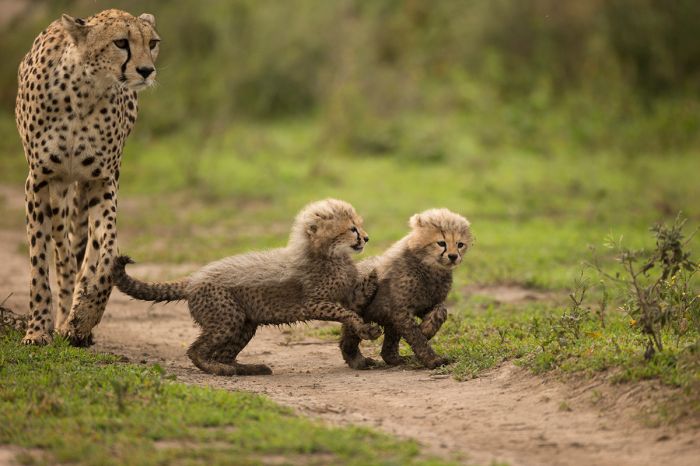
A cheetah with her two small cubs in the Serengeti.
The Great Migration
The annual movement of wildebeest and zebras across the Serengeti-Mara ecosystem is one of the greatest spectacles in the natural world. These large herds move in a circular track across southern Kenya and northern Tanzania, taking a full year to complete their cycle. The migration moves across both the Greater Masai Mara (in Kenya) and the Greater Serengeti (in Tanzania) in a fairly consistent pattern and timeframe. The animals move to take advantage of fresh grasses on which to graze.
The migrating herds of roughly 1.5 million blue wildebeests and several hundred thousand plains zebras spend about nine months of the year moving through Tanzania's Greater Serengeti and the other three months in Kenya's Greater Masai Mara. The migrating herds are in Tanzania's Greater Serengeti from sometime in October until around late-July (note that the timing is never precise and varies somewhat year to year). Note that the Serengeti is vast, and it is important to note where in the region the herds are located during this nine-month timeframe.
The animals spread out to cover a vast area, but the main bulk of the animals moves south into the northern Serengeti around late-October and continue moving south towards the Serengeti's southern plains, arriving there sometime in January to graze on the rich grass growing on the volcanic soils. It is here on these short-grass plains, between January and early March, when the wildebeests give birth to their young en masse, producing some 500 000 baby wildebeests.
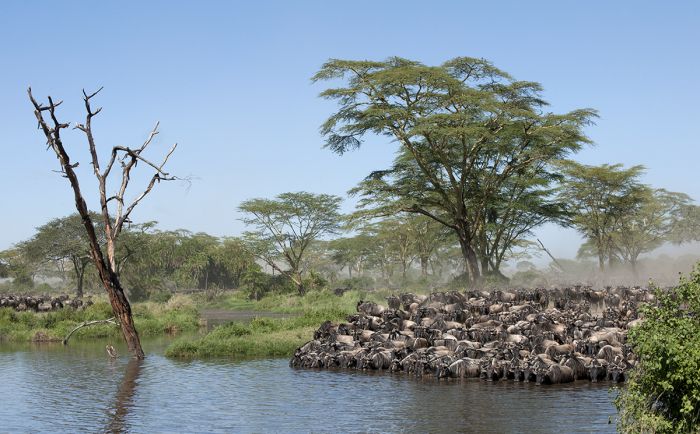
A large congregation of wildebeests during the Great Migration.
The herds remain on the southern short-grass plains until late March, giving the young animals time to grow and become strong, before heading north and west again. Many of the animals move towards the Serengeti's Western Corridor and Grumeti Reserve and the rest straight north into Central and Northern Serengeti, where they remain during June and into July. The herds move back into Kenya starting in late July, with the bulk moving into the Masai Mara in August.
The migration is rarely ever the same in terms of precise timing and direction, as local rains and other conditions influence grass growth. The wildebeest may, therefore, move off the open plains earlier in some years and remain in the northern Serengeti for longer in others. Nonetheless, the best months for seeing the migration in the Southern Serengeti are in February and March, when the herds are adding new babies, in the Central Serengeti during May and June, when the herds are the most concentrated, and in the Western Corridor, Grumeti, and far Northern Serengeti from June thru August.
Many visitors hope to witness dramatic river crossings, when hungry crocodiles attack the herds as they swim across the dangerous rivers of the Northern Serengeti. Like the migration in general, the precise timing of the river crossings is never known from year to year, but crossings on the Grumeti River are usually best in June, while Mara River crossings are best in July and August.




